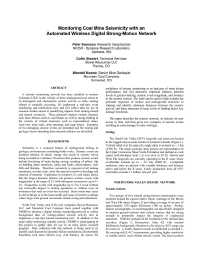Mining Publication: Monitoring Coal Mine Seismicity with an Automated Wireless Digital Strong-Motion Network
Original creation date: July 2008
A seismic monitoring network has been installed in western Colorado (USA) in the vicinity of three underground coal mines to (i) distinguish and characterize seismic activity as either mining related or naturally occurring, (ii) implement a real-time event monitoring and notification tool, and (iii) collect data for use in research studies aimed at quantifying impacts from mining-related and natural seismicity. These potential impacts include dynamic rock mass failures such as coal bumps as well as strong shaking in the vicinity of critical structures such as impoundment dams, reservoirs, mine seals, mine openings, and steep slopes. Examples of two damaging seismic events are presented and the mining and geologic factors attending these dynamic failures are described.
Authors: PL Swanson, C Stewart, W Koontz
Conference Paper - July 2008
NIOSHTIC2 Number: 20034344
Proceedings of the 27th International Conference on Ground Control in Mining, July 29 - July 31, 2008, Morgantown, West Virginia. Peng SS, Mark C, Finfinger GL, Tadolini SC, Khair AW, Heasley KA, Luo-Y, eds., Morgantown, WV: West Virginia University, 2008; :79-86
See Also
- Electromagnetic Noise in Itmann Mine
- Ground Monitoring
- Installation of a Digital, Wireless, Strong-Motion Network for Monitoring Seismic Activity in a Western Colorado Coal Mining Region
- Local Earthquake Tomography for Imaging Mining-Induced Changes Within the Overburden above a Longwall Mine
- The Relationship of Roof Movement and Strata-Induced Microseismic Emissions to Roof Falls
- Safer Mine Layouts for Underground Stone Mines Subjected to Excessive Levels of Horizontal Stress
- Seismic Event Data Acquisition and Processing: Distribution and Coordination Across PC-Based Networks
- Seismic Network Operations at a Deep Underground Coal Mining District in Western Colorado (USA)
- Task Analysis
- Time-Lapse Tomography of a Longwall Panel: A Comparison of Location Schemes
- Torso Flexion Loads and Fatigue Failure Mode of Human Lumbosacral Motion Segments
- Page last reviewed: 9/21/2012
- Page last updated: 9/21/2012
- Content source: National Institute for Occupational Safety and Health, Mining Program


 ShareCompartir
ShareCompartir
